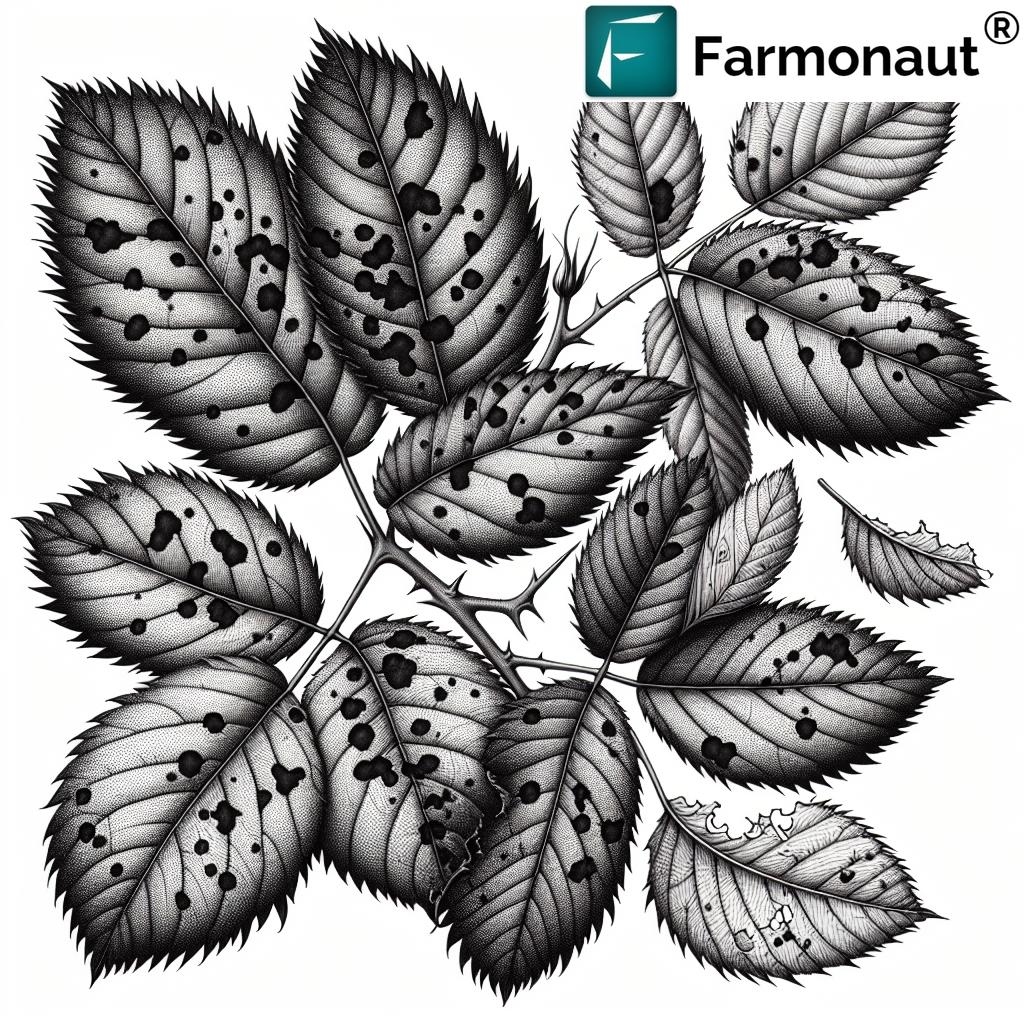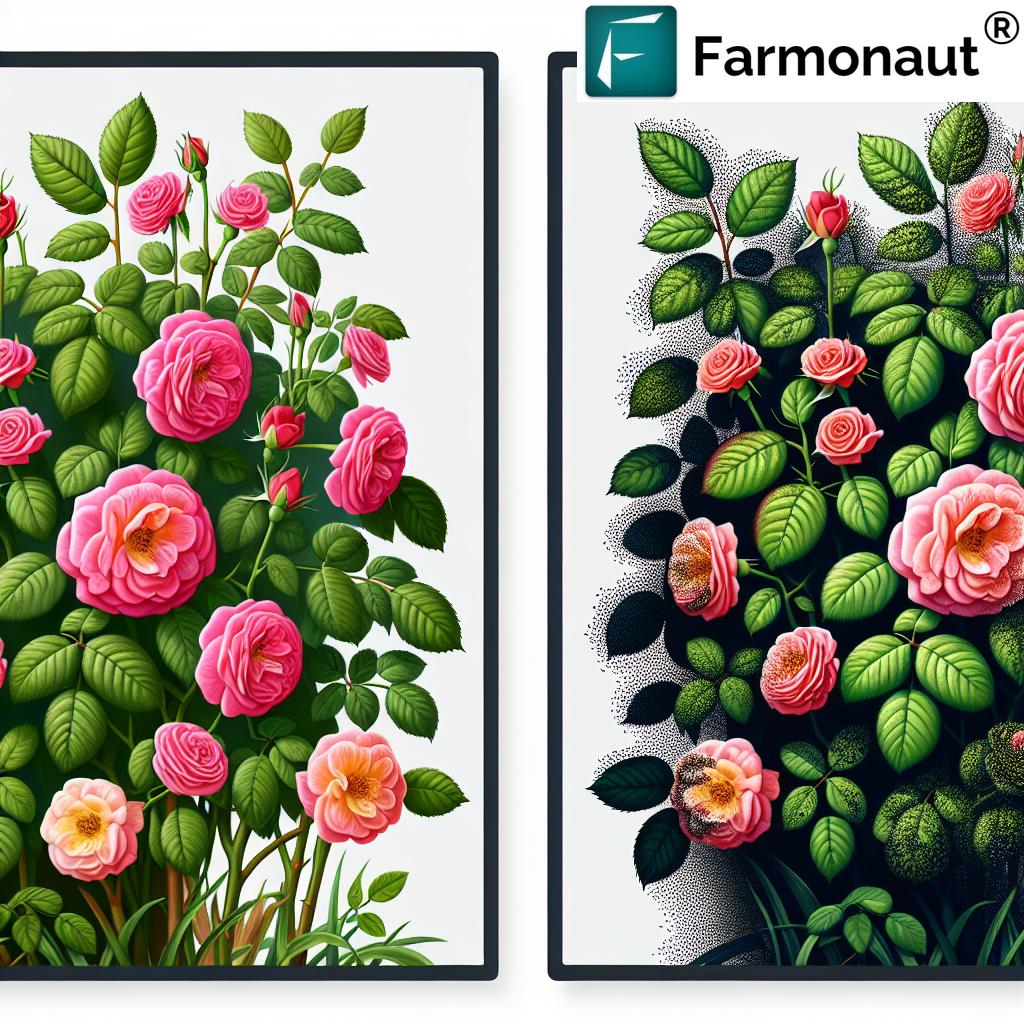Black Spot Disease in Roses: Comprehensive Guide to Organic and Chemical Control Methods

As passionate rose enthusiasts and agricultural experts at Farmonaut, we understand the challenges that gardeners and farmers face when it comes to protecting their beloved rose plants. One of the most common and persistent issues affecting roses is the dreaded black spot disease. In this comprehensive guide, we’ll delve deep into the world of this fungal menace, exploring its causes, symptoms, and most importantly, the various control methods available to keep your roses healthy and vibrant.
Understanding Black Spot Disease in Roses
Black spot disease is a fungal infection caused by the pathogen Diplocarpon rosae, which affects rose plants worldwide. This disease is not only unsightly but can also severely impact the health and vigor of your roses if left untreated. As we at Farmonaut have observed through our satellite-based crop monitoring system, black spot can spread rapidly under the right conditions, making early detection and intervention crucial.
The Science Behind Black Spot Disease
The scientific name of the fungus responsible for black spot disease is Diplocarpon rosae. This pathogen is highly specialized and primarily affects plants in the genus Rosa, making roses its primary host. Understanding the life cycle and behavior of this fungus is key to developing effective control strategies.
Symptoms and Identification
Recognizing the symptoms of black spot disease is the first step in managing this pest. Here are the key indicators to look out for:
- Spots on leaves: Circular black spots with fringed edges appear on the upper surface of leaves.
- Yellowing: The area surrounding the spots often turns yellow.
- Defoliation: Severely affected leaves may fall off prematurely, leading to defoliation.
- Stem lesions: In advanced cases, black lesions may appear on young stems.
- Weakened plant: Overall plant vigor decreases, with fewer and smaller blooms.
The Life Cycle of Black Spot Fungus
To effectively combat black spot disease, it’s essential to understand its life cycle:
- Spore production: The fungus produces spores on infected leaves and stems.
- Dispersal: Spores are spread by water splash from rain or irrigation.
- Germination: Under favorable conditions (high humidity and temperatures between 59-80°F), spores germinate on rose leaves.
- Infection: The fungus penetrates the leaf tissue and begins to grow.
- Symptom development: Spots appear on leaves within 3-10 days after infection.
- Repeat cycle: New spores are produced on infected tissue, ready to spread to other parts of the plant or nearby roses.
Factors Influencing Black Spot Disease
Several environmental and cultural factors can influence the development and spread of black spot disease:
- Weather conditions: High humidity and temperatures between 59-80°F are ideal for fungal growth.
- Water management: Overhead irrigation or frequent rain can facilitate spore dispersal.
- Plant density: Overcrowded plantings reduce air circulation, creating a favorable environment for the fungus.
- Seasonal changes: Black spot is often more prevalent in spring and fall when temperatures are moderate and moisture is abundant.
- Plant susceptibility: Some rose varieties are more resistant to black spot than others.
The Impact of Black Spot Disease on Rose Plants
Black spot disease can have severe consequences for rose plants if left unchecked:
- Reduced photosynthesis: Infected leaves are less efficient at producing energy for the plant.
- Defoliation: Premature leaf drop weakens the plant and reduces its aesthetic value.
- Stress: Infected plants become more susceptible to other diseases and pests.
- Decreased bloom production: The plant’s energy is diverted to fighting the infection, resulting in fewer and smaller flowers.
- Winter hardiness: Weakened plants may be less able to survive harsh winter conditions.
Preventive Measures for Black Spot Disease
At Farmonaut, we believe that prevention is always better than cure. Here are some preventive measures to reduce the risk of black spot infection:
- Choose resistant varieties: Select rose cultivars known for their resistance to black spot.
- Proper spacing: Plant roses with adequate space between them to improve air circulation.
- Sanitation: Remove and destroy infected plant debris regularly to reduce the fungal inoculum.
- Water management: Water at the base of the plant and avoid overhead irrigation.
- Prune properly: Remove crossed or crowded branches to improve air circulation within the plant.
- Mulching: Apply a layer of organic mulch to prevent spores from splashing onto lower leaves.
- Monitoring: Regularly inspect your roses for early signs of infection.
Organic Control Methods for Black Spot Disease
For gardeners who prefer organic approaches, there are several effective methods to control black spot disease:
- Baking soda spray: Mix 1 tablespoon of baking soda with 1 gallon of water and a few drops of liquid soap. Spray on plants weekly as a preventive measure.
- Neem oil: This natural fungicide can be effective against black spot when applied regularly.
- Compost tea: Spray compost tea on leaves to boost the plant’s natural defenses.
- Milk spray: A mixture of 1 part milk to 9 parts water can help prevent and control black spot.
- Garlic spray: Blend garlic cloves with water and strain. Dilute and spray on plants as a natural fungicide.
- Pruning: Remove infected leaves and stems promptly to prevent the spread of the disease.
Chemical Control Methods for Black Spot Disease
While we at Farmonaut encourage organic methods whenever possible, sometimes chemical interventions may be necessary for severe infections:
- Fungicides: Conventional fungicides containing chlorothalonil, myclobutanil, or propiconazole can be effective.
- Copper-based sprays: These can provide both protection and treatment against black spot.
- Systemic fungicides: These are absorbed by the plant and provide longer-lasting protection.
- Preventive sprays: Apply fungicides before symptoms appear, especially during susceptible periods.
Important: Always follow label instructions carefully when using any chemical control methods.
Integrated Pest Management for Black Spot Disease
At Farmonaut, we advocate for an integrated approach to managing black spot disease. This involves combining various control methods for the most effective results:
- Cultural practices: Proper planting, watering, and sanitation.
- Organic methods: Use of natural sprays and boosting plant immunity.
- Chemical interventions: Judicious use of fungicides when necessary.
- Monitoring: Regular inspection and early intervention.
- Record keeping: Tracking outbreaks and effectiveness of treatments.
The Role of Technology in Managing Black Spot Disease
At Farmonaut, we leverage cutting-edge technology to help farmers and gardeners manage plant diseases more effectively:
- Satellite-based monitoring: Our advanced system can detect early signs of stress in plants, potentially indicating disease outbreaks.
- AI-powered diagnostics: We’re developing algorithms to identify black spot disease from satellite imagery.
- Weather forecasting: Our platform provides accurate weather predictions to help time treatments effectively.
- Data-driven recommendations: We offer personalized advice based on your specific growing conditions and disease pressure.
To learn more about how our technology can help you manage black spot disease and other plant health issues, visit Farmonaut’s App.
Comparison: Traditional Methods vs. Farmonaut Satellite System
| Aspect | Traditional Methods | Farmonaut Satellite System |
|---|---|---|
| Early Detection | Relies on visual inspection, often detecting issues after symptoms appear | Uses multispectral imagery to detect plant stress before visible symptoms, enabling earlier intervention |
| Accuracy | Subject to human error and limited by what’s visible to the naked eye | High accuracy through AI-powered analysis of satellite data, detecting subtle changes in plant health |
| Coverage Area | Limited to areas that can be physically inspected, time-consuming for large areas | Can monitor vast areas quickly and efficiently, ideal for large-scale rose cultivation |
| Cost-effectiveness | Labor-intensive and potentially costly for large areas | More cost-effective for large-scale monitoring, reducing the need for frequent manual inspections |
Case Studies: Successful Management of Black Spot Disease
While we at Farmonaut don’t include specific case studies or success stories, we can share general observations from our experience:
- Many rose growers have successfully reduced black spot incidence by implementing a combination of cultural practices and targeted treatments.
- Early detection through regular monitoring and the use of technology has proven crucial in preventing widespread outbreaks.
- Growers who have adopted resistant varieties and implemented proper spacing have seen significant reductions in disease pressure.
- The use of organic methods, when applied consistently, has shown promise in managing black spot while maintaining ecological balance.
Future Directions in Black Spot Disease Management
At Farmonaut, we’re excited about the future of plant disease management, including black spot in roses:
- Advanced genetic research: Development of more resistant rose varieties through traditional breeding and genetic engineering.
- Precision agriculture: Using drones and satellite imagery for even more precise disease detection and treatment.
- Biological control agents: Research into beneficial microorganisms that can naturally suppress black spot fungus.
- Smart spraying systems: Development of automated systems that can detect and treat black spot with minimal human intervention.
- Climate change adaptation: Studying how changing weather patterns may affect black spot disease and developing strategies to adapt.
Conclusion
Managing black spot disease in roses requires a multifaceted approach combining prevention, monitoring, and targeted interventions. By understanding the biology of the fungus, implementing good cultural practices, and using appropriate control methods, rose enthusiasts can keep their plants healthy and beautiful.
At Farmonaut, we’re committed to providing cutting-edge solutions to help you manage plant health more effectively. Our satellite-based monitoring system and AI-powered analytics can give you valuable insights into your rose garden’s health, helping you stay one step ahead of diseases like black spot.
For more information on how Farmonaut can help you protect your roses and other crops, visit our API documentation or download our app for Android or iOS.
FAQ Section
Q: How often should I inspect my roses for black spot?
A: We recommend inspecting your roses at least once a week, especially during the growing season and in humid weather conditions.
Q: Can black spot spread to other plants in my garden?
A: Black spot is specifically a rose disease and doesn’t typically affect other plant species. However, it can spread easily between different rose plants.
Q: Is it safe to compost leaves affected by black spot?
A: It’s best to avoid composting infected plant debris as the fungus can survive in the compost and potentially reinfect plants.
Q: How long does it take for organic treatments to show results?
A: Organic treatments typically work more slowly than chemical options. You may start seeing improvements in 2-3 weeks with consistent application.
Q: Can I use Farmonaut’s technology for my small home garden?
A: While our satellite technology is most effective for larger areas, we’re developing solutions for smaller-scale applications. Stay tuned for updates!

Ready to take your rose cultivation to the next level? Subscribe to Farmonaut’s services and gain access to cutting-edge agricultural technology:
For more detailed information on our API and how it can benefit your agricultural practices, check out our developer documentation.